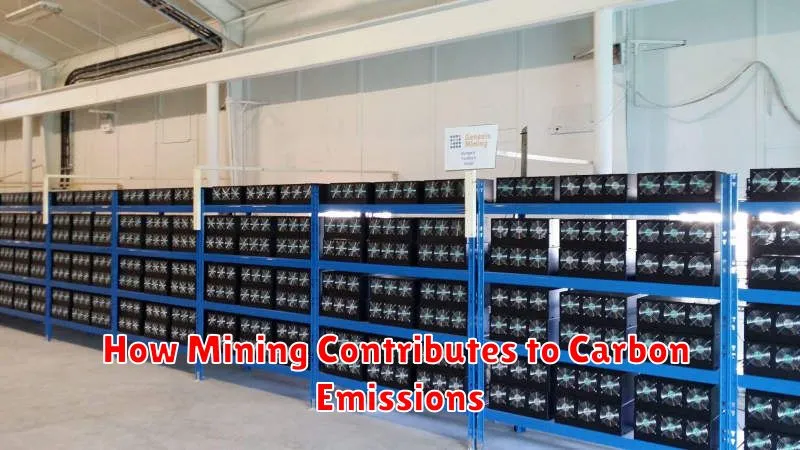The explosive growth of cryptocurrency has brought with it significant environmental concerns. This article explores the substantial environmental impact of cryptocurrency mining, examining its massive energy consumption, the resulting carbon emissions and contribution to climate change, as well as the broader ecological footprint of this rapidly expanding digital asset industry. We delve into the specific environmental problems associated with Bitcoin mining and other proof-of-work cryptocurrencies, and discuss potential sustainable solutions and eco-friendly alternatives.
Why Does Crypto Mining Use So Much Energy?

Cryptocurrency mining, particularly for proof-of-work systems like Bitcoin, is incredibly energy-intensive due to the computationally demanding process of solving complex mathematical problems to validate transactions and add new blocks to the blockchain. This process requires massive computing power, achieved through specialized hardware called ASICs (Application-Specific Integrated Circuits).
ASICs consume significant amounts of electricity to perform the complex calculations. The competition among miners to solve these problems and earn rewards further exacerbates energy consumption, leading to a continuous arms race for more powerful and energy-hungry hardware. The sheer scale of the global mining operation, with millions of machines operating simultaneously, results in a substantial overall energy footprint.
Furthermore, the energy used is often sourced from non-renewable sources, thus contributing directly to greenhouse gas emissions and climate change. The geographical location of mining operations, often in regions with cheap but polluting energy sources, also plays a significant role in the overall environmental impact.
Which Cryptos Use Proof-of-Work (PoW)?

Bitcoin (BTC) is the most well-known cryptocurrency utilizing the Proof-of-Work (PoW) consensus mechanism. Its energy consumption is a significant factor in the environmental impact discussion surrounding cryptocurrencies.
Ethereum (ETH), before its transition to Proof-of-Stake (PoS) in 2022, also relied on PoW. This contributed substantially to its energy usage.
Several other cryptocurrencies, including Litecoin (LTC), Dogecoin (DOGE), and Monero (XMR), continue to operate using the PoW consensus mechanism, each with varying degrees of energy intensity.
It is important to note that the energy consumption of these cryptocurrencies varies depending on factors like network hash rate, mining hardware efficiency, and the geographic location of mining operations.
How Mining Contributes to Carbon Emissions

Cryptocurrency mining, particularly proof-of-work (PoW) systems like Bitcoin, is a highly energy-intensive process. The process involves solving complex computational problems to verify transactions and add new blocks to the blockchain. This requires vast amounts of computing power, typically from specialized hardware like ASICs (Application-Specific Integrated Circuits).
The energy consumption translates directly into significant carbon emissions. The electricity powering these mining operations often comes from fossil fuel sources, including coal and natural gas, contributing substantially to greenhouse gas emissions. Even when renewable energy sources are used, the manufacturing and disposal of the mining hardware itself generate a considerable carbon footprint.
The scale of operations further exacerbates the problem. Mining farms, often located in regions with cheap electricity, can consume massive amounts of power, leading to a concentrated impact on local environments and the global carbon budget. The ever-increasing demand for cryptocurrencies intensifies the energy consumption and consequently, the carbon emissions.
Therefore, the environmental impact of cryptocurrency mining is largely driven by its reliance on electricity, the source of that electricity, and the lifecycle of the mining hardware. Addressing these aspects is crucial for mitigating the environmental consequences of this technology.
Efforts to Make Crypto Mining Greener

The cryptocurrency mining industry is facing increasing pressure to reduce its environmental impact. Several initiatives are underway to make mining greener. These include a shift towards renewable energy sources such as solar, wind, and hydro power to fuel mining operations.
Improved mining hardware is also playing a crucial role. More energy-efficient Application-Specific Integrated Circuits (ASICs) are being developed, significantly reducing the energy consumed per transaction.
Furthermore, innovative mining techniques like immersion cooling are gaining traction. This method improves cooling efficiency, reducing the amount of energy needed for cooling systems, a significant energy consumer in traditional mining setups.
Blockchain technology improvements are also contributing. Algorithms like Proof-of-Stake (PoS) require far less energy than the energy-intensive Proof-of-Work (PoW) mechanism used by Bitcoin. The broader adoption of PoS is a key factor in lowering the environmental footprint of cryptocurrencies.
Finally, increased transparency and accountability within the industry are critical. Companies are increasingly disclosing their energy consumption and sourcing practices, allowing for better monitoring and evaluation of their environmental performance. These efforts, while ongoing, represent significant steps toward a more sustainable cryptocurrency mining landscape.
Alternatives to Energy-Intensive Mining

The environmental impact of cryptocurrency mining, largely driven by the energy consumption of Proof-of-Work (PoW) consensus mechanisms, necessitates exploration of alternative approaches. Several promising solutions aim to reduce or eliminate the energy-intensive nature of traditional mining.
Proof-of-Stake (PoS) is a prominent alternative. Instead of competing to solve complex mathematical problems, validators are selected based on the amount of cryptocurrency they stake, significantly reducing energy consumption. This method relies on a consensus mechanism that prioritizes network security without the need for extensive computational power.
Proof-of-Authority (PoA) represents another approach, where a pre-selected group of validators is responsible for transaction verification. This method minimizes energy use by relying on the trustworthiness and reputation of the validators, rather than computational power. It’s particularly suitable for private blockchains.
Further innovations include Proof-of-Space and Proof-of-Delay, which focus on utilizing existing storage resources and time delays to secure the network, respectively, offering energy-efficient alternatives to PoW.
While each alternative presents its own trade-offs, exploring and implementing these less energy-intensive consensus mechanisms is crucial for mitigating the environmental impact of cryptocurrency.

